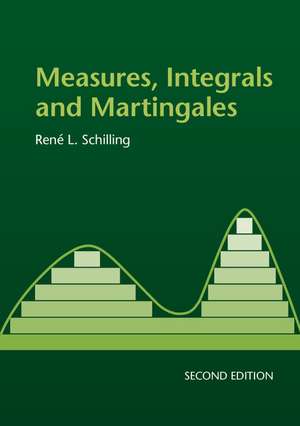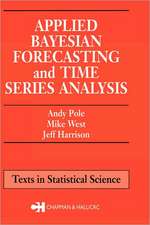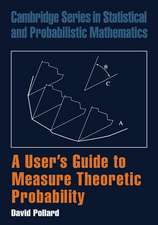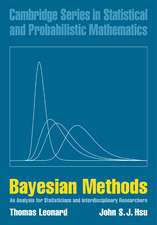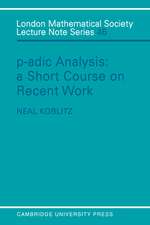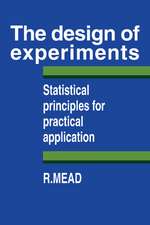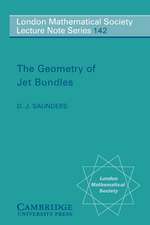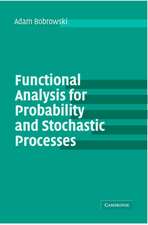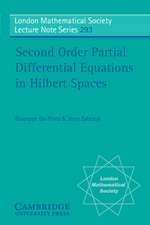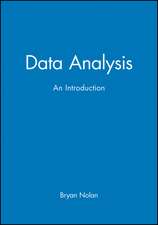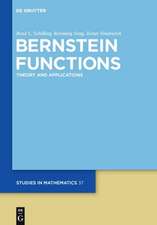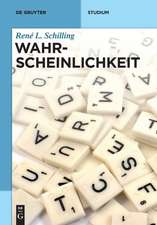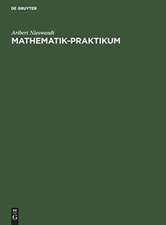Measures, Integrals and Martingales
Autor René L. Schillingen Limba Engleză Paperback – 2 apr 2017
Preț: 354.47 lei
Nou
Puncte Express: 532
Preț estimativ în valută:
67.84€ • 70.56$ • 56.00£
67.84€ • 70.56$ • 56.00£
Carte tipărită la comandă
Livrare economică 14-28 aprilie
Preluare comenzi: 021 569.72.76
Specificații
ISBN-13: 9781316620243
ISBN-10: 1316620247
Pagini: 490
Ilustrații: 40 b/w illus. 420 exercises
Dimensiuni: 174 x 247 x 22 mm
Greutate: 0.96 kg
Ediția:2Revizuită
Editura: Cambridge University Press
Colecția Cambridge University Press
Locul publicării:Cambridge, United Kingdom
ISBN-10: 1316620247
Pagini: 490
Ilustrații: 40 b/w illus. 420 exercises
Dimensiuni: 174 x 247 x 22 mm
Greutate: 0.96 kg
Ediția:2Revizuită
Editura: Cambridge University Press
Colecția Cambridge University Press
Locul publicării:Cambridge, United Kingdom
Cuprins
List of symbols; Prelude; Dependence chart; 1. Prologue; 2. The pleasures of counting; 3. σ-algebras; 4. Measures; 5. Uniqueness of measures; 6. Existence of measures; 7. Measurable mappings; 8. Measurable functions; 9. Integration of positive functions; 10. Integrals of measurable functions; 11. Null sets and the 'almost everywhere'; 12. Convergence theorems and their applications; 13. The function spaces Lp; 14. Product measures and Fubini's theorem; 15. Integrals with respect to image measures; 16. Jacobi's transformation theorem; 17. Dense and determining sets; 18. Hausdorff measure; 19. The Fourier transform; 20. The Radon–Nikodym theorem; 21. Riesz representation theorems; 22. Uniform integrability and Vitali's convergence theorem; 23. Martingales; 24. Martingale convergence theorems; 25. Martingales in action; 26. Abstract Hilbert spaces; 27. Conditional expectations; 28. Orthonormal systems and their convergence behaviour; Appendix A. Lim inf and lim sup; Appendix B. Some facts from topology; Appendix C. The volume of a parallelepiped; Appendix D. The integral of complex valued functions; Appendix E. Measurability of the continuity points of a function; Appendix F. Vitali's covering theorem; Appendix G. Non-measurable sets; Appendix H. Regularity of measures; Appendix I. A summary of the Riemann integral; References; Name and subject index.
Recenzii
Review of previous edition: '… thorough introduction to a wide variety of first-year graduate-level topics in analysis … accessible to anyone with a strong undergraduate background in calculus, linear algebra and real analysis.' Zentralblatt MATH
Review of previous edition: 'The author truly covers a wide range of topics … Proofs are written in a very organized and detailed manner … I believe this to be a great book for self-study as well as for course use. The book is ideal for future probabilists as well as statisticians, and can serve as a good introduction for mathematicians interested in measure theory.' Ita Cirovic Donev, MAA Reviews
Review of previous edition: '… succeeds in handling the technicalities of measure theory, which is traditionally regarded as dry and inaccessible to students (and, I think, the most difficult material that I have taught at undergraduate level) with a light touch. The book is eminently suitable for a course (or two) for good final-year or first-year post-graduate students and has the potential to revitalize the way that measure theory is taught.' N. H. Bingham, Journal of the Royal Statistical Society
Review of previous edition: 'This book will remain a good reference on the subject for years to come.' Peter Eichelsbacher, Mathematical Reviews
Review of previous edition: '… this well-written and carefully structured book is an excellent choice for an undergraduate course on measure and integration theory. Most good books on measure and integration are graduate books and, therefore, are not optimal for undergraduate courses … This book is aimed at both (future) analysts and (future) probabilists, and is therefore suitable for students from both these groups.' Filip Lindskog, Journal of the American Statistical Association
'This book is an admirable counterpart, both to the first author's well-known text Measures, Integrals and Martingales (CUP, 2005/2017), and to the books on counter-examples in analysis (Gelbaum and Olmsted), topology (Steen and Seebach) and probability (Stoyanov). To paraphrase, the authors' preface: in a good theory, it is valuable and instructive to probe the limits of what can be said by investigating what cannot be said. The task is thus well-conceived, and the execution is up to the standards one would expect from the books of the first author and of their papers. I recommend it warmly.' Professor N. H. Bingham, Imperial College London
Review of previous edition: 'The author truly covers a wide range of topics … Proofs are written in a very organized and detailed manner … I believe this to be a great book for self-study as well as for course use. The book is ideal for future probabilists as well as statisticians, and can serve as a good introduction for mathematicians interested in measure theory.' Ita Cirovic Donev, MAA Reviews
Review of previous edition: '… succeeds in handling the technicalities of measure theory, which is traditionally regarded as dry and inaccessible to students (and, I think, the most difficult material that I have taught at undergraduate level) with a light touch. The book is eminently suitable for a course (or two) for good final-year or first-year post-graduate students and has the potential to revitalize the way that measure theory is taught.' N. H. Bingham, Journal of the Royal Statistical Society
Review of previous edition: 'This book will remain a good reference on the subject for years to come.' Peter Eichelsbacher, Mathematical Reviews
Review of previous edition: '… this well-written and carefully structured book is an excellent choice for an undergraduate course on measure and integration theory. Most good books on measure and integration are graduate books and, therefore, are not optimal for undergraduate courses … This book is aimed at both (future) analysts and (future) probabilists, and is therefore suitable for students from both these groups.' Filip Lindskog, Journal of the American Statistical Association
'This book is an admirable counterpart, both to the first author's well-known text Measures, Integrals and Martingales (CUP, 2005/2017), and to the books on counter-examples in analysis (Gelbaum and Olmsted), topology (Steen and Seebach) and probability (Stoyanov). To paraphrase, the authors' preface: in a good theory, it is valuable and instructive to probe the limits of what can be said by investigating what cannot be said. The task is thus well-conceived, and the execution is up to the standards one would expect from the books of the first author and of their papers. I recommend it warmly.' Professor N. H. Bingham, Imperial College London
Notă biografică
Descriere
A concise, elementary introduction to measure and integration theory, requiring few prerequisites as theory is developed quickly and simply.
